As noted in the first article of this series some months ago, piston engines are best thought of as air pumps. The more air the engine pumps the more power it can make. We can also recall that it’s the weight of the atmosphere above the engine that pushes the air into the cylinders, so called natural aspiration.
Of course, the higher an engine flies, the less atmosphere is above it. The mass of air entering the engine is reduced by roughly 3% per 1000 feet of altitude, so that at 10,000 feet, about one-third of sea-level engine power goes missing. Ask any Cessna 150 captain.
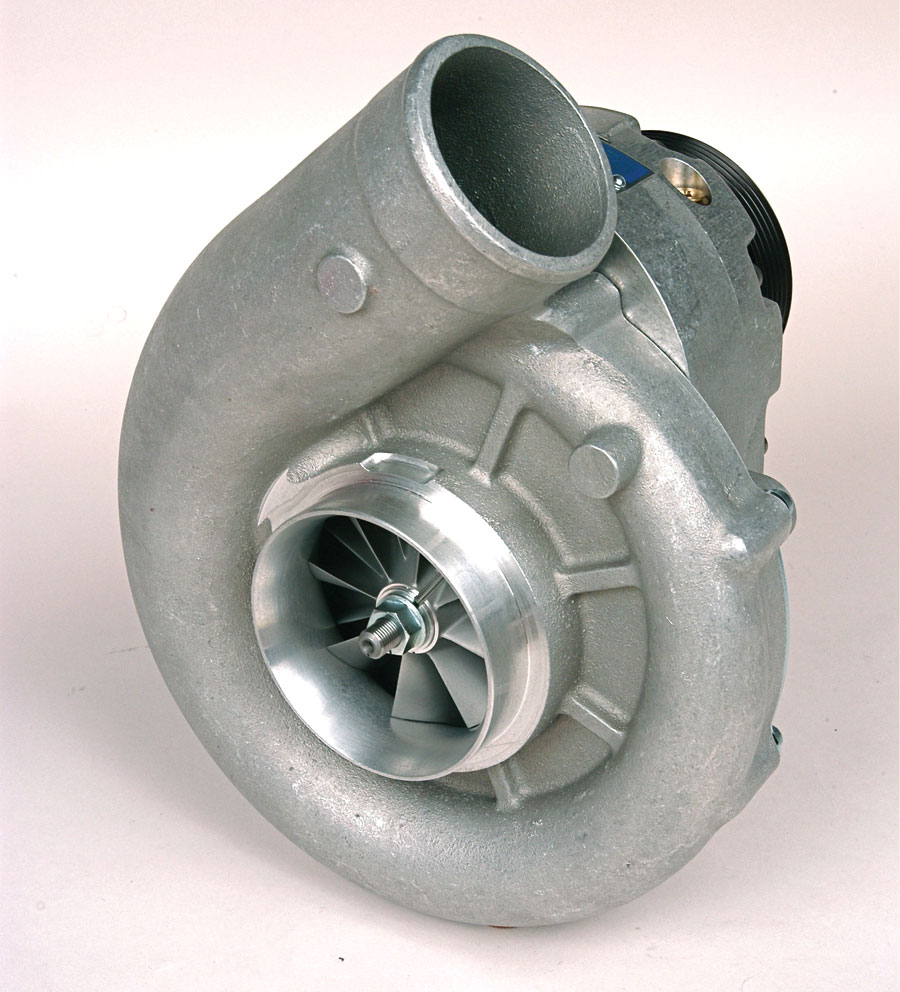
Like turbocharger compressors, centrifugal superchargers such as this Vortech unit take air in their center, turn it 90 degrees and blow it through the snail-shaped volute. The fast-rotating impeller blades are visible here at the air inlet. On the backside of this assembly is a spur-gear drivetrain that helps increase impeller rpm 10 to 12 times over crankshaft speed.
The engineering solution is forced induction. That is, the addition of any device or system using energy to push more atmospheric mass into the engine’s cylinders. In the vernacular, this is supercharging—super meaning “raised” or “above” and “charge” referring to the air/fuel charge in the cylinder. There are surprisingly numerous ways to supercharge an engine. It’s all great stuff, and every engine should be supercharged and all that—except there is no free lunch. Cost, complexity, and technical issues abound with supercharging and, as the market has shown, for our low-altitude, low-performance aircraft, simple large-displacement engines are normally the most elegant option. Of course, some of us want to go higher and faster!
One supercharging fundamental is compressing a gas (such as air) raises its temperature. Given light compression—boost in the hot rodder’s and English aviator’s argot—this temperature rise is minor and can be ignored. But as boost rises, the temperature gain threatens to induce detonation, plus if you cool the charge air, you can get more of it into the cylinder’s fixed volume and make more power. Thus, somewhere around 8 pounds of boost—46 inches of manifold pressure as we aviators would see it—there’s a need for charge cooling. Cooling is also a must in the mid-teens and lower flight levels because the atmosphere is so thin there a high degree of supercharging is needed just to maintain sea level manifold pressure.

Thomas Shapkow’s Lysholm Screw supercharged Acroduster Too exemplifies experimental forced induction thinking. Offering big power increases up to mid-altitudes, the tidy system avoids the packaging and heat complications of turbocharging. For more see www.g3ignition.com.
Almost everyone down at the flying field calls this intercooling, but pedantics such as ourselves quickly point out that cooling after the supercharger is aftercooling, and intercooling refers to a charge cooler between stages of a multi-stage supercharging layout (one turbo blowing into another turbo, for example). So we’ll use the more inclusive charge cooling moniker.
Another source of heat is whatever inefficiencies are introduced by the supercharger itself. There’s always some shearing and batting of the air, and some superchargers are much worse than others in this regard, and that heat can add significantly to the rise in charge air temperature. Hint: not all boost showing on the manifold pressure gauge is due to increased air density; hot, expanded air moves the needle upwards, too.
In general aviation most charge coolers are air-to-air radiators, again, almost exclusively referred to as “intercoolers.” But given a liquid-cooled engine, air-to-water charge cooling is possible and has its packaging advantages. The storied Rolls Royce Merlin used air-to-water cooling, for example.
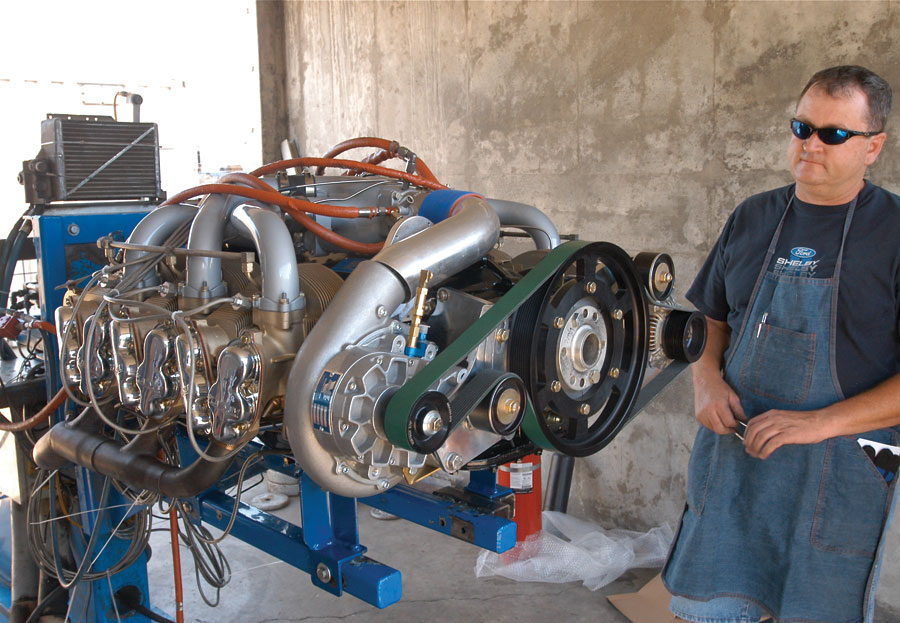
Adapting the Vortech to an airplane engine requires a specialized belt drive. The large crankshaft pulley is a necessary part of the blower’s step-up gearing. This is a Forced Aeromotive Technologies kit being fitted on Ly-Con’s dynamometer during development. There is no charge cooling, and the only other plumbing job is feeding engine oil to and from the Vortech’s bearings.
Something else to mention is it is more effective to lower the engine’s compression ratio and rely on boost to make power with a forced inducted engine. This is a factor in highly boosted engines—which we mainly don’t have in general aviation—and typical Lycoming/Continental compression ratios are fairly low to begin with. But it’s worth knowing that engines with low compression ratios and lots of boost are fuel hogs and power dogs when off boost. Like everything, a bit of supercharging is often good, but engineering for huge manifold pressures has significant side effects.
Goal of Supercharging
OK, so a little boost is a good thing. What are we trying to accomplish with it? Down at sea level plenty of people simply want more torque and horsepower to make their hot rods go faster. Bent toward aviation, these people can be found tearing around pylons in Reno, Nevada, each September. But big power at low altitudes is consumptive (of everything), leading to the hot rodder’s maxim, “Speed costs money; how fast do you want to go?”
More mainstream is the desire to preserve the engine’s naturally aspirated sea level power at much higher altitudes. In other words, the engine never experiences boost, but simply maintains power as it climbs. This is normalizing, or turbo-normalizing when accomplished with turbochargers. This is quite efficient because air resistance diminishes as the plane climbs, but the power does not.
Of course, at some altitude the supercharging system cannot maintain sea level power anymore (remember, all engines are naturally aspirated upstream of the supercharger). This is that engine’s critical altitude, and above it a supercharged engine’s power diminishes at the same rate as a naturally aspirated engine. But the supercharged engine begins losing its sea level horsepower far above sea level, so it still has a great advantage even above its critical altitude.
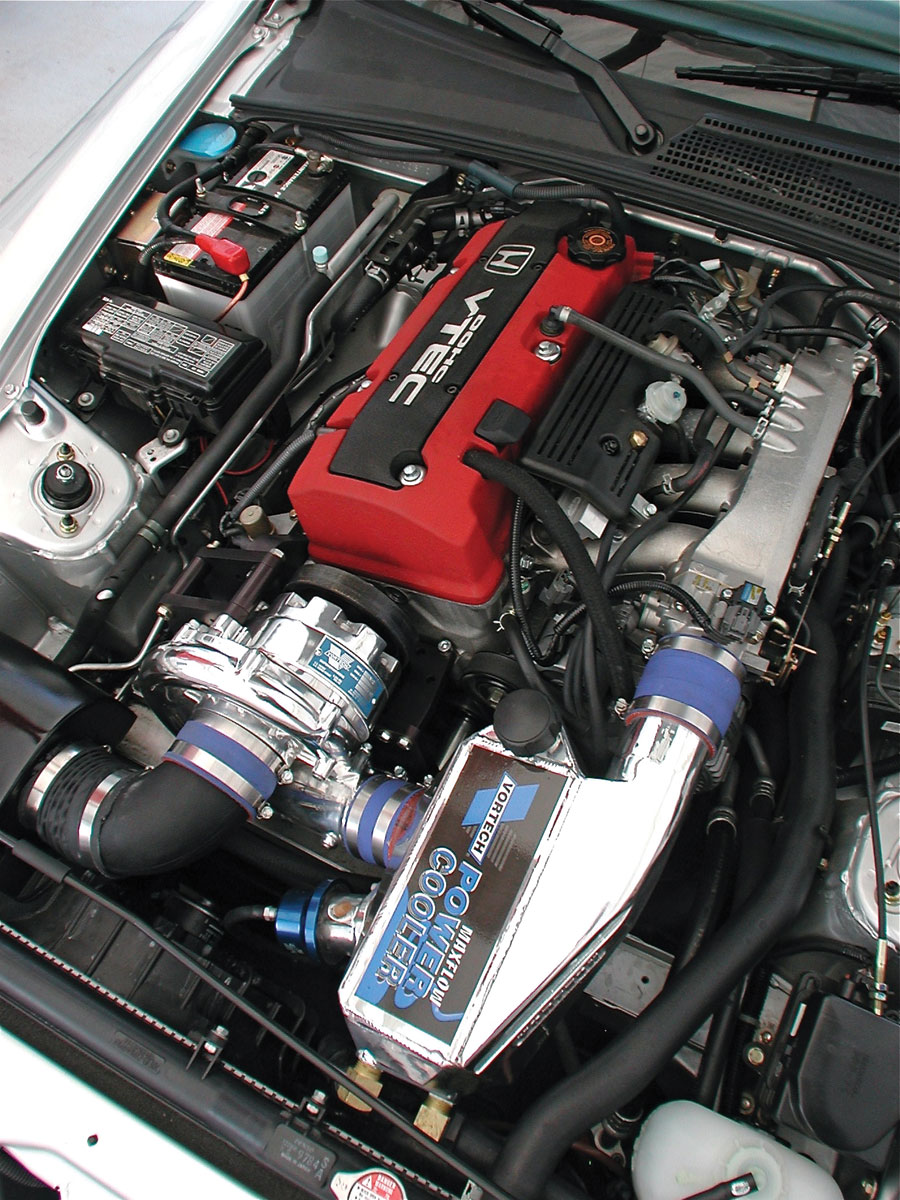
Vortech makes air-to-air and water-to-air charge coolers; the latter is shown on a 358-hp Honda S2000 automotive installation. It’s the polished shoebox with the “Power Cooler” logo, and on a water-cooled engine provides greater packaging freedom to the designer, as it did on the P-51 Mustang. In fact, with the supercharger belt driven immediately in front of the engine, this installation hints at the streamlined possibilities a boosted 4-cylinder engine could have.
Types of Superchargers
An incredible number of crafty concepts have been used to supercharge piston engines, but generally a series of engine-driven blowers and compressors, plus the familiar exhaust-driven turbocharger, have been the aviation choices.
Engine-driven superchargers include the centrifugal, Roots, TVS, and Lysholm Screw designs. All of these share a reliance on crankshaft power to drive them. That means some engine power, and gasoline, is used to drive the supercharger and not available to the propeller.
This is an important point. It can take 75 hp to drive a supercharger making 14 psi of boost that adds 100 hp to an engine. So, if a naturally aspirated 250-hp engine is supercharged to make 350 hp at the propeller, that engine is actually making approximately 425 hp, burning the fuel to make 425 hp, is stressed like a 425-hp engine (because it is a 425-hp engine), and must reject the heat of a 425-hp engine. The “missing” 75 hp is consumed driving the supercharger.
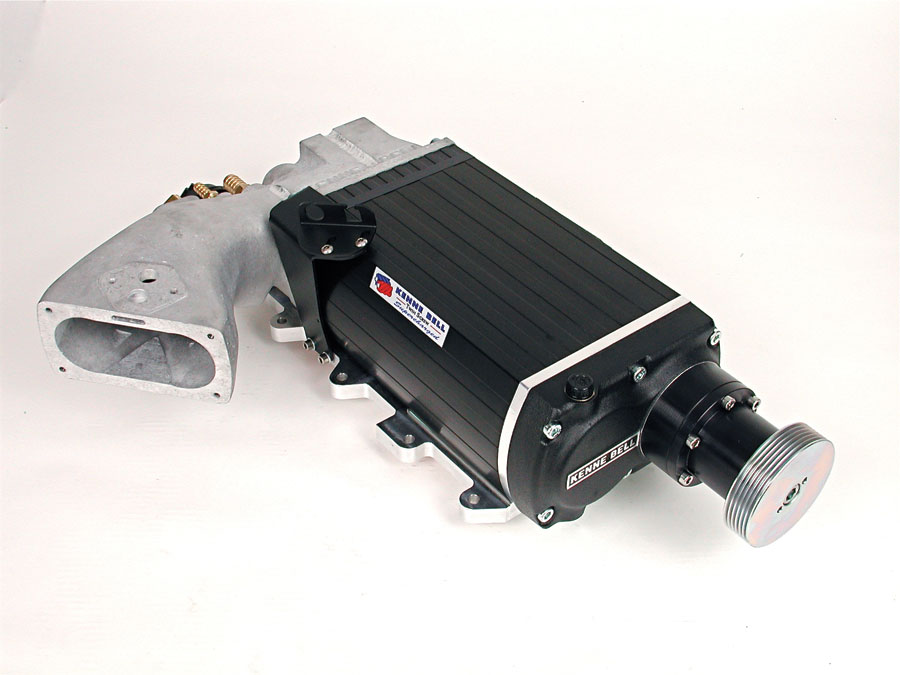
Kenne Bell is a prominent maker of Lysholm Screw compressors for performance cars. This KB supercharger is belt driven at the right end; the aluminum duct at left is the air inlet that always feeds on the end of an LS design. The compressed air discharge is not visible here and is underneath the pulley end in this example.
Of the superchargers just listed, only the centrifugal has seen wide aviation use; centrifugals were on all but the smallest radials during the round-motor heyday, along with boosting the big V-12s and some of the prewar inlines. A few postwar horizontally opposed engines were centrifugally supercharged as well.
Centrifugal blowers are fairly common industrial air-movers, including the ubiquitous pistol-grip hair dryer. The hair dryer uses an electric motor to spin an impeller—fancy name for a fancy paddle wheel—while on an engine either a belt or gear drive transfers power from the engine’s crankshaft to the impeller. The intake air path has a 90-degree turn at the impeller, which spins inside a snail-shaped volute housing. The volute can either discharge as a pipe, or on radial engines the air is flung outwards to the individual intake pipes for each cylinder.
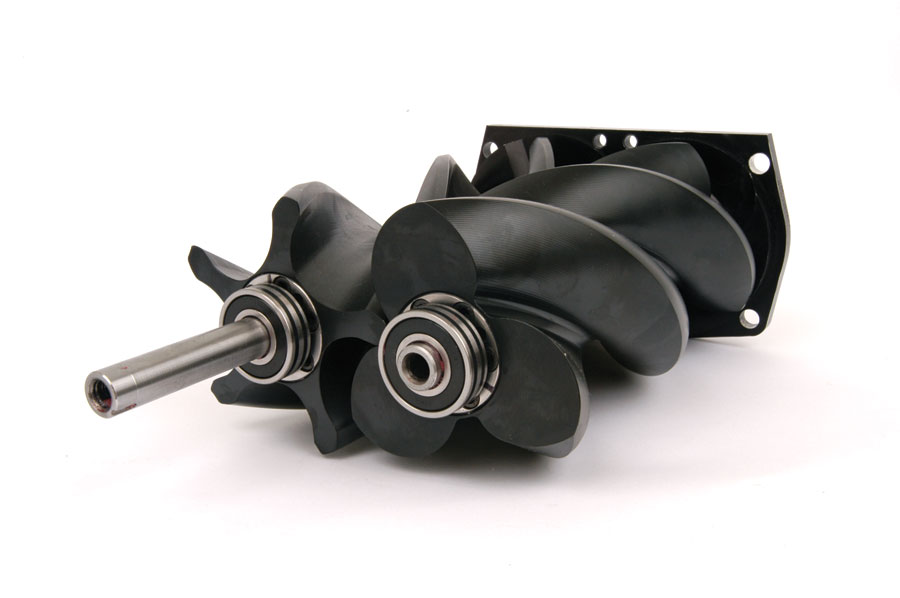
Remove the housing and the female (left) and male (right) rotors of the Lysholm Screw design are readily apparent. Air travels from one end of the rotor back to the other, not across it as with a Roots. The rotor shape gradually constricts, pressurizing the air. Typical rotor speed is about 12,000 rpm; the rotors run within .003 inch of each other, but never touch.
Centrifugal superchargers are high-speed devices. The belt or gear drives—modern aftermarket superchargers such as the popular Vortech use both a belt drive to the supercharger and a gear drive inside the supercharger—achieve around 12:1 increases from crankshaft speed. So, a 2700-rpm Lycoming spins the impeller about 32,000 rpm. This makes one heck of a fan, one that moves far more air than the engine would normally ingest. The air piles up in the intake tract downstream of the supercharger; this slowing of the air means increased density (greater air mass) waiting at the intake valve.
Centrifugal superchargers are one of the most efficient in handling the intake air. For all their whiz-wheel motion, the intake air is only lightly abused and gains modest heat from the supercharger.
The exact opposite is true of the much lower speed Roots blower, which had its aviation moment around WW-II. Originally designed for ventilating coal mines, the Roots reached huge production numbers as a ventilator on 2-stroke diesel truck engines, so the design continues on old-school automotive hot rods. Also typically belt-driven, the Roots uses two intermeshing paddles (each resembling a rolling pin pinched into a rough figure-eight shape to form air-trapping lobes) in a breadbox housing. Relatively inexpensive to make, the Roots is efficient as a high-volume, low-pressure fan, but when sped up to supercharging speeds its adiabatic (heat) efficiency is pretty horrible. Discharge air temperatures can reach well over 300F, so it’s a prewar historical waypoint in aviation supercharging.
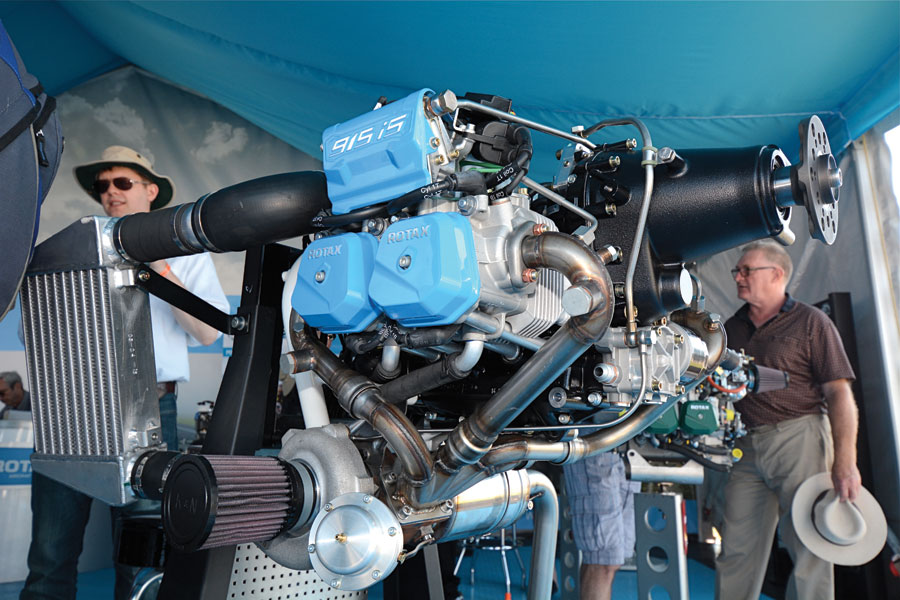
Rotax’s turbocharged 915iS is the modern, affordable, production turbo engine and should give great performance when it finally hits the market in 2017. The turbo sits below the blue valve covers and is partially covered by the wastegate controller, while the air-to-air charge cooler is at left. It offers 135 sea-level horsepower to 15,000 ft and service ceiling of 23,000 feet. Bring your mittens.
Today the Eaton Corporation makes the TVS—Twisted Vortices Supercharger—version of the Roots for mainstream automakers. Here the rotors are twisted along their long axis to improve adiabatic efficiency significantly. This blower is durable and in high-volume production (at least it was until recently) for use by everyone from Ford to Mercedes. It’s better than a Roots for sure and affordable.
Outwardly looking like a Roots or TVS, the Lysholm Screw is a whole nother kettle of impellers inside. Instead of the Roots simple rotors, the Lysholm Screw uses a pair of very complex, intermeshing screws, one male, the other female. Adiabatic efficiency is good—centrifugals just beat it in a relatively narrow operating range—and the design is the new standard in automotive hot rodding where instant engine response is king and weight tolerance is more lenient than at the airport. Naturally, it costs a bit more than a TVS.
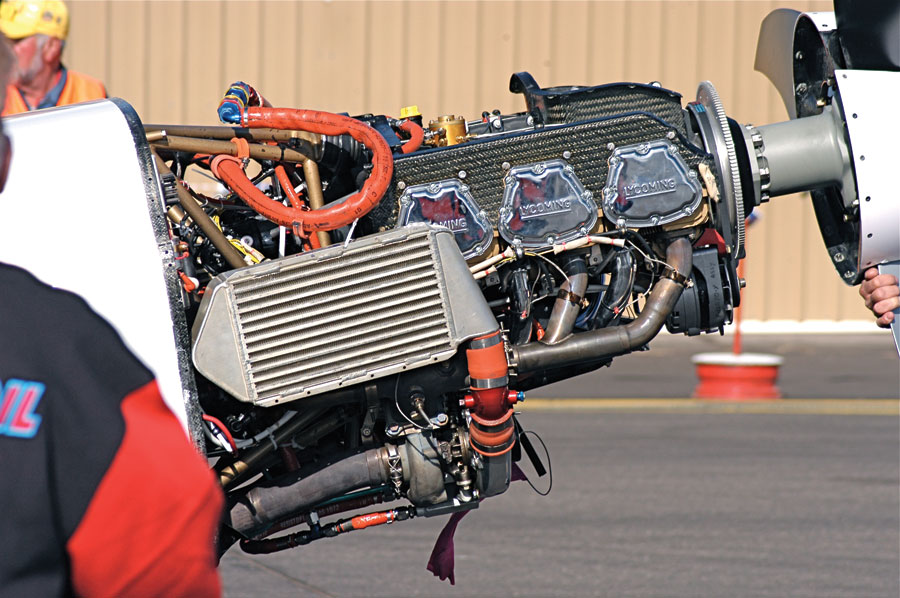
Nemesis NXT’s mega-powered turbo-Lycoming packages the charge cooler sideways along the engine compartment to keep the air path short from turbo to engine. The unfriendly, tight packaging of this sophisticated turbo installation illustrates the practical servicing access and possible heat-affectation issues of such systems.
The box shape, end air intake, and annular discharge port of the Lysholm Screw makes it a little easier to package (for a machinist) under a Lycoming or Continental, and Tom Shpakow has run one to good effect. Shpakow is a dedicated experimenter and engineered his own installation on his 540-Lycoming-powered Acroduster Too sport biplane. Operating out of Denver, the Lysholm provides altitude compensation (normalizing), plus extra boost for true supercharging (40 inches) to give sparkling 3000-fpm vertical performance, along with crisp throttle response during aerobatics. The Lysholm’s good adiabatic numbers and the relatively light supercharging needed at low- to mid-altitudes means Shpakow need not worry about charge cooling, which aids the cost, complexity and packaging concerns.
All that said, Shpakow says his system requires a fair bit of manual operation and isn’t for the average guy.
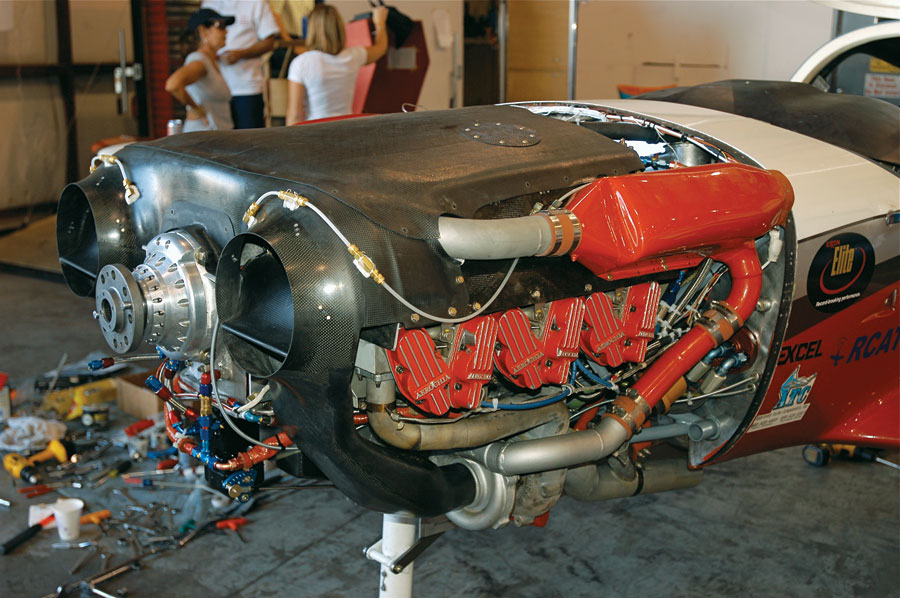
Another take on charge cooler placement is seen on the Aerochia-derived installation on Darryl Greenamyer’s TSIO-550 Continental in his Lancair Legacy racer. The two main air inlets feed—very carefully we might add—the turbos, charge coolers and engine cooling. The charge coolers are inside the red bumps atop the plenum-cooled engine.
And then there’s turbosupercharging, aviation’s go-to forced induction. Conceptually, a turbocharger couples a centrifugal supercharger with a turbine wheel in the exhaust stream to provide the rotational power. Thus, the good efficiencies of the centrifugal are combined with recovery of some of the exhaust energy otherwise wasted out the exhaust pipe. This makes turbos king of forced induction fuel economy, plus the tremendous energy available in the exhaust means significant supercharging is available even at high altitudes. It also means turbos are typically smaller diameter and spin faster than centrifugals; the latest generation of small-diameter turbos in mainstream automotive production reach 240,000 rpm. Which brings up another fact; turbo systems are very much in development for ground vehicles these days, with spin-off technology and economies for aviation.
While turbocharging was identified as the best aviation supercharger and mandated in U.S. military aircraft as early as 1918 in Signal Corps tests, the concept takes effort to get right in reality. If nothing else, turbocharging is something of an intake and exhaust plumbing nightmare, especially on sophisticated systems, and it results in significantly increased under-cowl, CHT and EGT heat. This is because the exhaust system offers more backpressure, plus exposed surface area under the cowling, and those surfaces are hotter due to the higher fuel burn accompanying increased power. The metals involved need to be the best high-temperature alloys, the result being increased cost, more design trade-offs when packing the system, along with frustrating access to the engine during maintenance.
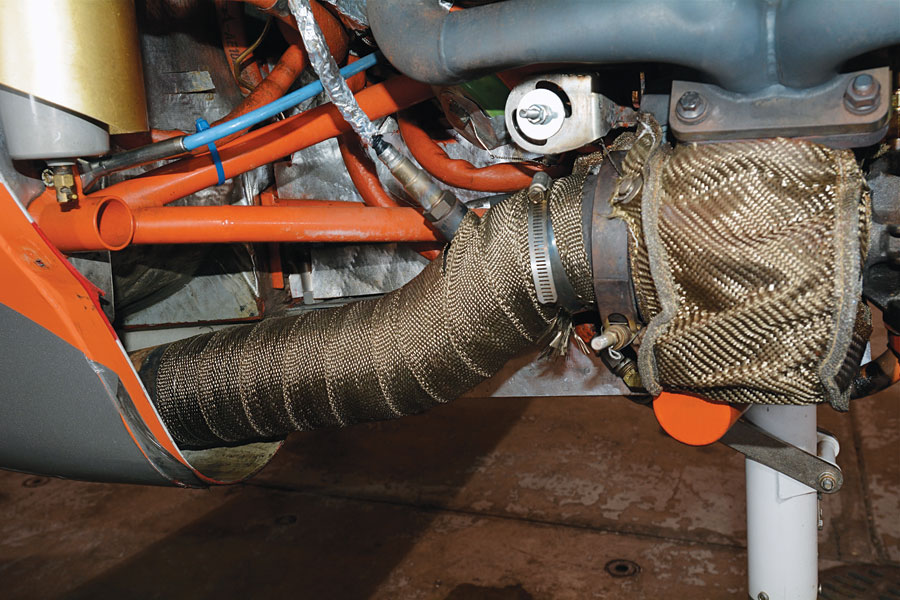
Another illustration of turbocharger heat is this heat-wrap party on Andrew Findlay’s Stihl-sponsored Lancair Reno racer. Keeping heat in the turbocharger improves its efficiency and keeping heat out of the engine compartment saves rubber parts such as engine mount cushions from an early death.
Because turbos feed off the high-energy exhaust, a throttle-like wastegate valve is provided to vent excess exhaust before it reaches the turbo. At low altitude or low boost needs, the wastegate is opened and most exhaust gas bypasses the turbo. At high altitude or for more boost generally, the wastegate is closed partially or totally. More exhaust gas is routed through the turbo, which then spins faster and with more energy. It is possible to size the turbo to the engine’s maximum power needs and eliminate the wastegate, but such systems require excessive pilot interaction and are no longer popular.
We should note that multiple superchargers can, and have been, mounted in series. This was the norm in WW-II and on big radials where a large centrifugal blew into a smaller centrifugal, plus two- and sometimes three-speed gearboxes were fitted. Many WW-II engines had engine-driven centrifugals and exhaust-driven turbochargers, such as the B-17, P-47, P-38, etc. All this was to meet the low- medium- and high-altitude air requirements of the piston engine, and all such complexity has been replaced today by simpler turbo-only systems with wastegates. The latter effectively act as infinite ratio transmissions.
Nitrous Oxide
A totally different way to cram more oxygen into the combustion chambers is to feed air from a pressurized bottle, as if you stole it from a gas welder. Pure oxygen has been attempted, but is so touchy that nitrous oxide is the speed industry’s choice. It contains two nitrogen and one oxygen atom per nitrous oxide molecule, making it much easier to control than pure oxygen.
A nitrous system consists of a heavy, high-pressure bottle containing liquid nitrous at a nominal 950 psi. Solenoid-operated valves open to allow bottle pressure to push the liquid nitrous to the engine’s intake, where upon leaving the nozzle, the nitrous expands furiously, turning into a gas and aggressively dropping temperature. A second set of pipes and pumps (or electronic control of the vehicle’s electric fuel pump) supply the necessary extra gasoline to maintain proper air-fuel ratio, so a nitrous system has both a nitrous and gasoline side.
Nitrous is a very powerful power adder. The energy in the system is gained from the pump that filled the bottle, not the engine’s exhaust or crankshaft. The cooling effect is powerful and helpful in avoiding detonation, and it’s fairly easy to add lots of nitrous for massive power gains. Reno racer Rare Bear sports a 500-hp nitrous “hit,” for example.
But nitrous is also the high-maintenance prima donna of forced induction. Nitrous system tuning revolves around the bottle pressure, which varies with its temperature and must be maintained with electric heaters; it’s difficult to carry more than two minute’s worth of boost and is only usable at full-throttle anyway. It’s great for setting climb records, pylon racing, and getting off of sandbars in the boondocks, but even aerobatic hard cores would soon tire of tending to the bottle—and the recurring cost of filling it. Best advice with nitrous is to take it easy and jet for moderate power increases.
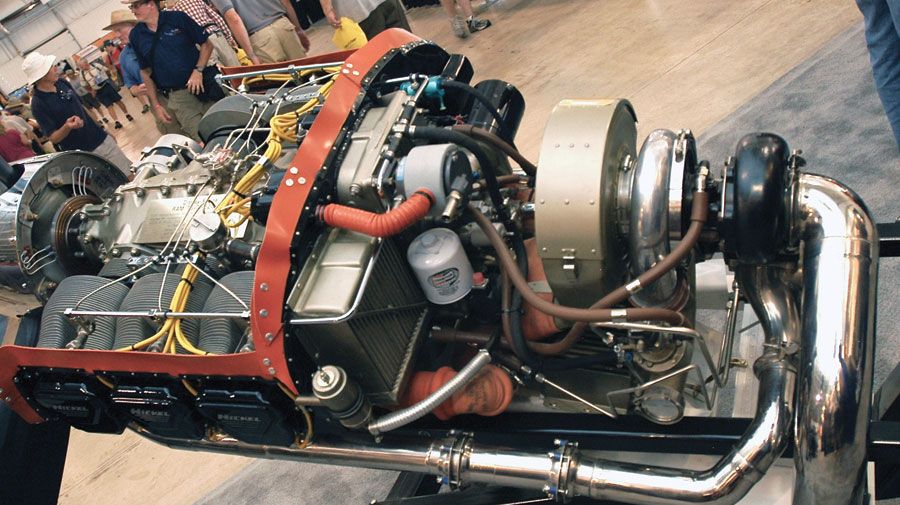
Turbos are often used in parallel pairs, mainly for packaging and throttle response reasons, but one larger single turbo provides just as good an engineering solution in our steady-state rpm engines. It also packages more aerodynamically when spotted behind the engine as in this RAM TSIO-520.
Practical Supercharging
All told, turbocharging is the clear front runner in aviation forced induction. Even so, it’s pricey and a pain to work around, so unless the mission always calls for 10,000+ feet of altitude, most of us would go without. One area experimenters might profitably employ engine-driven superchargers—either centrifugal or TVS/Lysholm Screw—is either side of 10,000 feet. Fuel economy is not stellar, but the power is good, packaging possibly superior, and heat issues non-existent as long as a free-flowing exhaust system is used. It would seem a good alternative for sport and heavy-lift aircraft plying the mid-general-aviation altitudes.


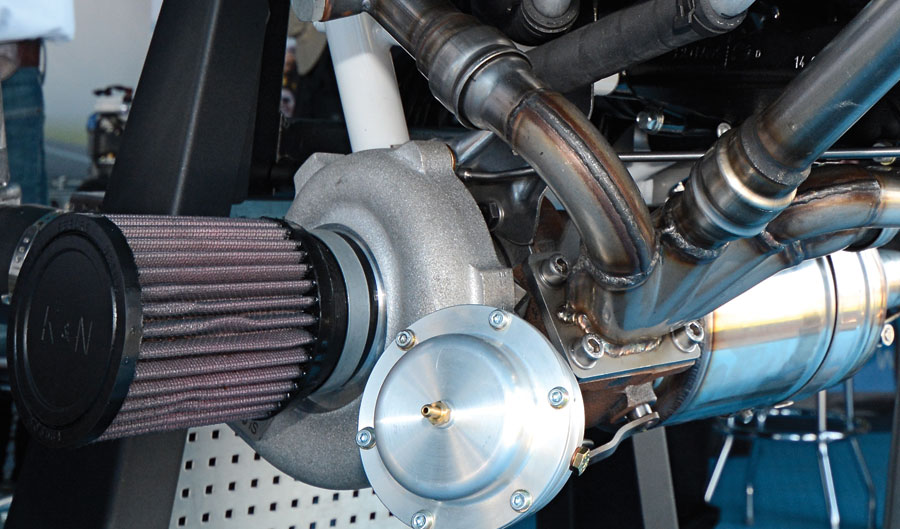




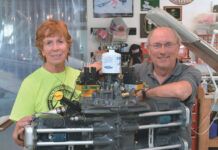
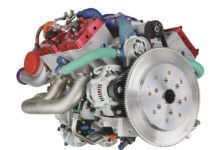
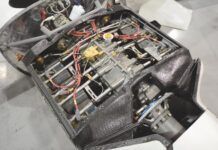
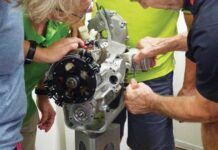

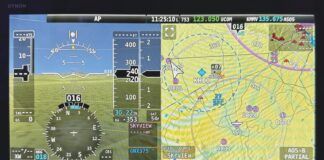
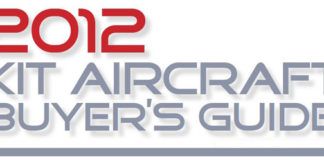
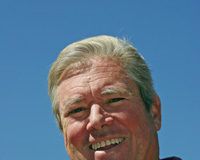

For selecting of turbocharger, can we installed 2 turbocharger on Rotax 914 engine for boosting more Powe at high altitude above 16,000feet?
Twin turbochargers are usually used where rapid throttle response is required (as in a car).Twin turbos are sometimes easier to package on fee engines, too. That said, a larger single turbo is the likely better solution for more supercharging the 914 Rotax. If supercharging is increased significantly (enough to matter) there will no doubt be a fair amount of re-engineering required, such as larger charge coolers, exhaust pipe diameters and so on.
Excellent explanation of a complex subject, Tom. Thanks!